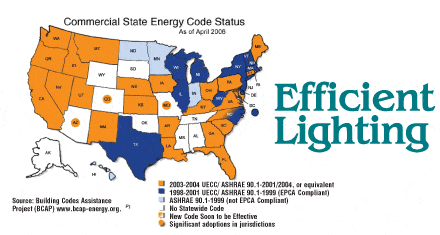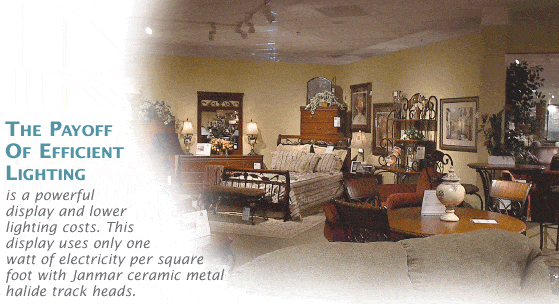A story of rates, regulation and cost saving opportunities.
In the October 2005 issue of FURNITURE WORLD I opened an article on lighting by saying, “Gasoline price boards are getting pretty scary. Maybe you have wondered if the skyrocketing price of oil will cause your electricity bill to go up. In some places it might. Oil prices are going to drive all business costs up.” My crystal ball was in the shop so I had little idea of just what the future impact might be.
By the April 2006 High Point market gas had gone up almost another dollar and customers from all points of the compass were reporting proposed utility rate increases of up to 75%. Those increases were against a base rate of 12 cents per kilowatt-hour on the East Coast and 15 cents out west. The implications of government, wielding a two edged sword of regulation and tax deductions, aimed at retail lighting had also become more clear by April.
The lighting “environment” made up of electricity rates, rebates and regulations will certainly make the cost of lighting your stores more expensive. So what can you do? You can’t display your products to their best advantage without good lighting. It remains the key ingredient to your presentation, the way customers perceive your merchandise. What do you need to know about the lighting environment in your stores? How can you respond to cost increases in a way that benefits your business? These are more global questions than what light bulb to use.

Electricity Supply and Demand
There is a lot of news coverage today on how the law of supply and demand is affecting gas prices. There is simply more demand for gas than the present rate of investment can match. The same is true for electricity. The impact of higher demand for electricity has resulted in recent blackouts in the east, failure of the distribution grid surrounding the Great Lakes and daily brown outs during the summer months, in California.
Increasing capacity to generate or distribute electricity can take 20 years or more from planning stages to “lights on.” Utilities have used a rebate strategy for years to buy down demand from some consumers so they can supply others. One rebate program in southern California offered businesses $27 million if only they would invest in more efficient warehouse lighting. The money was snapped up in three days.
Rebates give utilities a way to buy back demand, so current capacity can be used to supply growth. They tend to be “spot” programs of limited funding or duration.
If you are looking at changes to your store’s lighting to improve displays or reduce energy consumption, you should call your local utility, for details. The fact is, rebate programs can lower the cost of your investment in more efficient lighting.
Lighting Regulations
Regulation is another tool that is used to bring supply and demand into balance. The regulation of commercial lighting has increased significantly over the last five years. The rules are spelled out by the American Society of Heating Refrigerating and Air-Conditioning Engineers (ASHRAE). Why? In a commercial building, lighting accounts for one third of total energy consumption. Heating, ventilating and air conditioning (HVAC) and other uses consume the remaining two thirds. Lighting heat contributes to the HVAC load because each watt of electricity used in lighting is a watt of heat the HVAC must handle.

ASHRAE issued major lighting standards in 1999, 2001 and 2004. In 2002 the Department of Energy gave states two years to adopt the 1999 standard or incorporate it into their commercial building codes. Of course many states didn’t make the deadline, but now all have some form of lighting regulation in place.
The significance for you as a furniture retailer is that ASHRAE standards limit the watts per square foot that can be used for lighting. The most stringent limitation is California’s energy code, known as Title 24, that limits retail lighting to 1.5 watts per square foot. This means that a furniture store in California with a room display in an 11x14-foot space is “allowed” 308 watts. If the display were illuminated by four, 90-Watt halogen lamps (total 360 watts), the store would be in violation of the code. As codes get more restrictive, retailers are being forced to adopt more efficient lighting sources or sacrifice the quality of their displays.
At the Federal Level
Last fall, Congress passed the Energy Policy Act of 2005 (EPAct 2005) as part of a continuing effort to bring supply and demand into balance. Under this act, furniture stores that “do things right” can receive a tax deduction of up $1.80 per square foot for new construction.
pgrading lighting in your existing store will earn a deduction of 60 cents per square foot. It’s as simple as that.
What EPAct 2005 says to furniture store owners is, “Let’s make sure your showrooms and lighting are efficient, to cut down on HVAC load and reduce energy consumption. If you are not planning new buildings, lets make it desirable to replace inefficient lighting and reduce energy consumption.” (Of course no law is that simple. For a more complete description see an excellent summary by Sylvania Lighting at http://content.sylva
nia.com/app/display.aspx?id=003687078)
Doing things right in lighting new construction is kind of a “no-brainer.” Many states have more stringent standards than the 1999 version EPAct 2005 uses as a benchmark. By complying with state or local code, you earn some if not all of the 60-cent deduction and you won’t get a permit to build unless you comply with code. But what about updating your current store? Can that be done to qualify for the deduction, give better lighting and lower operating costs?
Taking Advantage of the Law
Chances are good that a home furnishings store built 15 years ago (or more) can update lighting to earn the maximum tax deduction. Most of these older stores use 3.7 watts per square foot or more. Two characteristics of inefficient stores are “old” fluorescent fixtures and wall-to-wall track.
By “old” fluorescent fixtures I mean the four T12 lamp fixtures with a plastic sheet covering the fixture. These fixtures typically have magnetic ballasts and maybe even a charming hum when operating. EPAct 2005 makes it illegal to use these fixtures for new construction.
Today’s fixtures have two or three T8 lamps, a more open parabolic lens to let more light out of the fixture and electronic ballast. The combination of features cuts energy consumption by half, while maintaining light levels and improving the quality of light.
Some stores, like High Point showrooms, are “track only.” When there were no energy constraints and electricity was cheap, lighting design often meant taking a ruler and drawing lines every 10 feet or so from one wall to another. Labeling the line as “track” and adding a symbol for track heads every two feet completed the “design” process. If you have this type of lighting in your store, merchandise will have ample accent light, but the store, in general, will appear dark in stark contrast to every other shopping experience your customers have.
Energy regulations in effect today, “charge” watts to the lighting allowance for every foot of track, whether or not there is a single light bulb installed. The code people figure you wouldn’t put it up if you didn’t plan to use it, even though some of it goes over the top of walls!
By using efficient halogen bulbs in combination with fluorescent fixtures a lighting design can provide product impact, a brighter selling environment and a pleasant shopping experience for about 2 watts per square foot. That will qualify for nearly the full tax deduction but exceeds the watt limit in California and other states. Depending on limits and electricity rates in your area it may be necessary to use the latest technology, ceramic metal halide, to get the presentation and efficiency you need.
The Payoff of Efficient Lighting
Lets look at an example of how converting to efficient lighting can reduce your operating costs. For this example we won’t even consider the effect that higher wattage has on heating and air conditioning costs.
If you operate a 30,000 square foot store, a nice size for full line, and use 3.5 watts per square foot, total watts are 105,000. By multiplying 105,000 by 4,000 hours, your annual operating hours, and dividing by 1,000, to convert to kilowatts, you get 420,000 kilowatt-hours. That number multiplied by an electricity rate of 10 cents per kilowatt-hour gives us an annual cost of $42,000 for lighting.
The same store with efficient lighting burning 2 watts per square foot would cost $24,000 to operate. That’s a pretty big difference in my book. A lighting system based on ceramic metal halide track lighting usually comes in at about one watt per square foot. Maybe you guessed the electricity bill answer: $12,000 per year.
Retail stores are not required to reduce energy consumption, but you can see the benefits of efficient lighting and the impact it can have on your bottom line. Whether you change to more efficient light bulbs, replace obsolete fixtures or renovate your lighting system to take advantage of the tax deduction, there are steps you can take to control operating costs.
Monte Lee is a Regional Manager for Service Lamp Corporation, a distributor of lighting products and services. Inquiries on any aspect of furniture store lighting can be sent to him at mlee@furninfo.com. See all of Monte Lee’s articles on store lighting posted to the Operations Management Article archives section of the www.furninfo.com website.